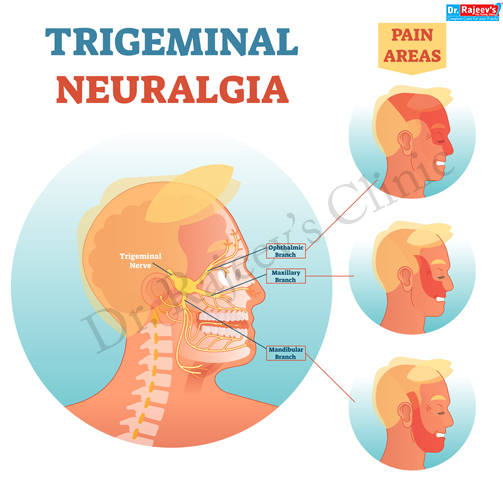

Twelve nerves (called cranial nerves) from the brain control the major activities of the head, face, and neck; including the vision, hearing, smell, taste, sensations, and more. One of the twelve cranial nerves is called Trigeminal Nerve since it has three (tri) branches.
Definition:
Trigeminal neuralgia (TN) is an inflammation of the trigeminal nerve which is the fifth cranial nerve arising from the brain. It causes episodes of severe, sharp, electric shock-like pain in areas of the face where branches of the nerve are distributed such as the lower jaw, upper jaw, nose, lips, forehead, eyes, and scalp.
Trigeminal neuralgia is the most painful condition known to the human race and can also lead to suicidal thoughts or depression in some patients due to its intense pain.
TYPES OF :

1) Typical trigeminal neuralgia: Typical trigeminal neuralgia is characterized by periodic episodes of electric shock-like pain on either side of the face which could be triggered by certain activities, such as brushing the teeth, talking, chewing etc.
2) Atypical trigeminal neuralgia: In atypical trigeminal neuralgia, patients experience a consistent heavy, dull, aching pain or burning sensation in one part of the face which gradually gets worse. There is no specific trigger point for pain.
The exact cause of trigeminal neuralgia is not yet fully understood, however, in many cases, it has been observed the loss of covering (myelin sheath) over the nerve gives rise to the severe pain. It may occur due to an abnormal compression of the nerve by a blood vessel in the brain, trauma to the nerve caused by an injury or during the dental treatment, multiple sclerosis, and tumors around the nerve are some other causes.
The patient may experience frequent episodes of sharp intense pain at every few hours or every few seconds. In between the episodes, the pain is completely relieved and the person would not experience any symptoms. In some patients, the pain is constant dull aching, burning affecting either the right or left side of the face.
Trigeminal neuralgia can be diagnosed clinically based on the symptoms and proper physical examination. There are no specific tests or investigations needed to be done to diagnose trigeminal neuralgia. However, to rule out other pathological conditions, such as multiple sclerosis or tumor, CT scan or an MRI is done. So, as a rule, every patient of trigeminal neuralgia is advised to get an MRI done to rule out a hidden tumor.
The conventional line of treatment comprises the use of anti-convulsive medicines, such as carbamazepine, phenytoin, and gabapentin, baclofen, which help most of the patients. However, they are habit forming and need to be continued for months to many years at the cost of several adverse effects.
Trigeminal neuralgia is a chronic and difficult condition to treat, and one always needs a supplemental treatment along with conventional medicines to manage the case in the better way. No single system of medicine is adequate to manage this severe painful disease.
Homeopathic medicines help to relieve the frequency, duration, and intensity of episodes of trigeminal neuralgia. They are absolutely safe and do not interfere with the conventional medicines, and they prove to be an effective alternative mode of medicine. Homeopathic medicines help to control the underlying nerve damage process without causing any side-effects even after they are taken as a long-term treatment. The dose of the conventional medicines can be tapered eventually, and the dependency on conventional medicines can be reduced in some cases. Some patients, who have started homeopathy at an early stage, can successfully stop the conventional medicine over a substantial period of time.
Spigelia: Spigelia markedly affects the nervous system, particularly the Trigeminal nerve. It positively influences the heart, eyes and the head. A few of its characteristic symptoms are as follow : Stabbing pains which make the patient shudder. Pains come suddenly and go suddenly. Violent tearing, burning, jerking pains in individuals who are very sensitive to touch.
Syphillinum : Syphillinum is a deep acting, polycrest remedy affecting multiple systems of the body. It positively influences the mind, sensorium, skin, gastrointestinal tract, genito-urinary system, nerves, bones, etc. It is a very helpful remedy to combat hereditary syphilitic tendencies in patients. Syphillinum is frequently used in the homeopathic treatment of trigeminal neuralgia. Severe, violent, sharp pains characterize this remedy.
Staphysagria : It is one of the most frequently used medicines for trigeminal neuralgia.
Cinchona officinalis (China ): China is frequently used in the treatment of neuralgic pains. there is marked debility in the patient due to the loss of vital fluids. The patient is weak and nervous and oversensitive to pain. Periodicity of the complaints is marked with complaints recurring every alternate day and symptoms getting invariably worse at night. Pains are worse from touch, draft of air and from jerky movements.
NEURALGIA DROP, NEURAL DROP